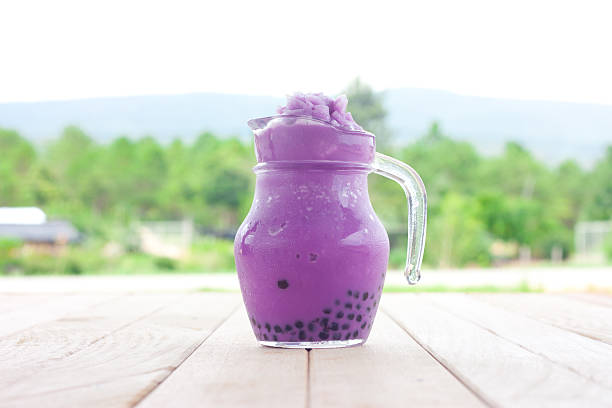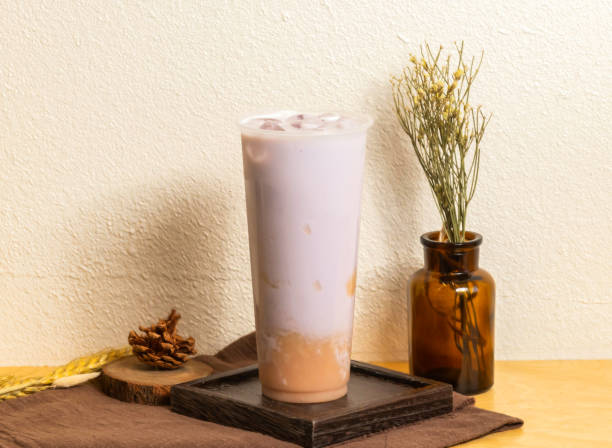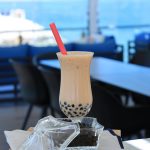Taro milk tea, a mesmerizing blend that captures the essence of exotic flavors and creamy textures, has emerged as a beloved choice among bubble tea aficionados worldwide. But what exactly does this distinctive beverage taste like, and why has it garnered such a passionate following? Delving into the heart of this delicious enigma, our exploration is not merely about quenching thirst; it’s an invitation to a sensory journey that intertwines tradition with modern culinary innovation. Taro, a root vegetable revered in many cultures for its nutritional benefits and versatile culinary applications, lends itself to creating a beverage that is both intriguingly complex and comfortingly familiar.
As we unravel the layers of taro milk tea’s flavor profile, you’ll discover how its unique taste—a harmonious blend of nutty, vanilla-like sweetness with a hint of earthiness—sets it apart from other bubble tea variants. This article aims not only to describe the indescribable but also to illuminate the cultural significance and craftsmanship behind every sip. Whether you’re a seasoned bubble tea enthusiast or a curious newcomer, the insights shared here promise to deepen your appreciation for taro milk tea and maybe even inspire you to explore the broader world of bubble tea flavors.
Join us as we navigate through the subtleties of what does taro milk tea taste like, uncover the secrets behind its captivating purple hue, and reveal how to discern quality in this delightful beverage. By the end of this journey, you’ll not only understand what taro milk tea tastes like but also why it deserves a special place in the pantheon of bubble tea flavors. Prepare to be tantalized by the allure of taro milk tea—a drink that transcends simple refreshments to become a true culinary experience.
Taro and Bubble Tea Basics
To fully appreciate taro bubble tea, we first need to understand the key ingredients that make this drink so delicious.
What is Taro?
Taro is a starchy root vegetable that originally came from Southern India and Southeast Asia. It is a versatile ingredient used in many cuisines across the Asia Pacific region. Taro has a brown, fibrous outer layer and an inner purple flesh with a unique nutty and earthy flavor.
Some key facts about taro:
- Taro contains complex carbs and fiber. It is naturally fat-free and high in vitamins and minerals like vitamin A, vitamin C, potassium, magnesium, phosphorous, manganese, and more.
- There are many varieties of taro, but one called dasheen (or Chinese taro) is most commonly used for cooking and bubble tea.
- In addition to the root, taro leaves are edible and used in dishes like the Hawaiian staple – laulau.
- Taro is sometimes called the “potato of the tropics” and can be prepared boiled, fried, or mashed into a paste.
The Rise of Bubble Tea
Bubble tea originated in the 1980s in Taiwan when tea stands started adding chewy tapioca balls, or “boba pearls”, as a topping. These drinks quickly became a hit across Asia.
By the 1990s, bubble tea made its way to North America when Chinese immigrants brought the trend over. Taro joined the lineup of bubble tea flavors after businesses realized it made a perfect, creamy companion to the tapioca pearls.
Here are some bubble tea milestones:
- 1980s – The first tapioca bubble tea is created in Taiwan.
- 1990s – North Americans get their first taste of tapioca bubble tea as it spreads from Asia.
- Early 2000s – Taro bubble tea gains popularity as vendors recognize it as an ideal flavor.
- 2010s – Taro bubble tea goes mainstream as Korean pop culture and social media drive its global fame.
So how did humble taro become a bubble tea superstar? As we’ll explore next, it has the ideal taste, texture, and versatility to shine in bubble tea form.

Diving Into Taro Bubble Tea
Now that we’ve covered the basics, let’s dive deeper into taro bubble tea itself – its ingredients, taste profile, and how to make it yourself.
Understanding Taro Bubble Tea
At its core, taro bubble tea features just a few main ingredients:
- Brewed black or green tea – The tea base provides the signature tea flavor.
- Taro paste – Taro root that is boiled, peeled, then blended into a creamy paste. Sweetened condensed milk or sugar is also added.
- Tapioca pearls – Chewy tapioca balls that provide fun texture contrast.
- Milk – Usually dairy or non-dairy milk. It helps create the signature creaminess.
From this basic formula, there are many ways to customize your taro bubble tea:
- Vary the amount of sugar in the taro paste to your taste preference.
- Select different teas like jasmine, oolong, Earl Grey, matcha, etc.
- Use fruit juices instead of milk for a lighter option.
- Add toppings like pudding, grass jelly, red beans, etc.
- Make it into a slushy or smoothie instead of standard iced tea.
See more : Can Almond Milk Constipate You? Almond Milk Truth
No matter how you change it up, taro bubble tea always delivers its signature violet color and sweet nutty flavor.
Making Taro Bubble Tea at Home
Want to save money by recreating this favorite drink at home? Here is an easy DIY recipe:
Ingredients:
- 1 cup taro paste
- 1 cup black tea, brewed & chilled
- 1/2 cup milk of choice
- 1/4 cup tapioca pearls, cooked
- Ice cubes
- Sugar to taste (optional)
Instructions:
- Brew black tea and allow to chill completely.
- Cook tapioca pearls according to package instructions. Drain and set aside.
- Add taro paste, milk, and a dash of sugar (if desired) to a blender. Blend until smooth.
- Pour tea into a tall glass filled with ice cubes. Leave room at the top for toppings.
- Add taro mixture to the glass. Stir gently to combine.
- Top with tapioca pearls. Enjoy with a bubble tea straw.
For a vegan version, use coconut milk and replace white sugar with maple syrup or agave. You can also add grass jelly, red beans, or fruit like mango for more flavor and texture.
Taro bubble tea is simple to make at home once you have the key ingredients on hand. It’s a fun drink to customize and share with friends.
What Does Taro Milk Tea Taste Like?
So, what does taro milk tea taste like? Taro milk tea has a unique flavor profile that combines sweetness with nuttiness. Described as tasting somewhat like vanilla with a hint of nuttiness, taro root itself has a light, slightly sweet, and nutty flavor that pairs well with milk, sugar, and black tea in the preparation of milk tea. The purple color of taro bubble tea comes from the taro root, a root vegetable native to Southeast Asia, known for its mildly sweet and nutty taste when blended into bubble tea. Additionally, taro has a mild nutty taste that becomes sweet when mixed with sugar, offering an earthy and starchy texture.
Beyond the Taro Milk Tea Taste
While taro bubble tea is certainly delicious, it also has a deeper cultural significance. The use of taro spans history, geography, and cuisine. Let’s explore taro’s lasting impact.
Cultural Significance
For many cultures, especially across Asia and the Pacific, taro is more than just food – it has a deeply rooted cultural importance. For instance:
- In Hawaii, taro or kalo is considered a sacred elder sibling to Native Hawaiians. Taro features prominently in Hawaiian myths and legends.
- Chinese mythology links taro cultivation to the exploits of the god Shennong, celebrated as the father of agriculture.
- The Japanese have cultivated taro for centuries and use it in dishes like kinpira gobo. It is associated with the underworld in Japanese myths.
- In India, taro leaves are used during popular Hindu festivals like Ganesh Chaturthi to worship the elephant god Ganesh.
Clearly, taro holds significance beyond nutrition across many Asian and Pacific cultures. The use of taro root in bubble tea connects to these long, sacred histories.
Global Variations and Innovations
While taro bubble tea originated in Taiwan, the drink has undergone delightful adaptations as it spread worldwide:
- Philippines: Taro milk tea with cream cheese foam is iconic Filipino-style bubble tea.
- Thailand: Toppings like coconut jelly, grass jelly, and floating clouds (egg foam) put a Thai twist on creamy taro tea.
- Korea: Koreans love mix-ins like rice cakes and sweet red beans in taro bubble tea.
- Japan: Matcha green tea and azuki beans complement the taro in Japanese variations.
- United States: Taro bubble waffles sandwich creamy taro tea and pearls between soft, griddled waffles.
There’s no wrong way to taro when it comes to bubble tea. Part of the experience is discovering new taro taste combinations.
Health and Nutrition
See more : What Is Taro Milk Tea? | A Guide To This Popular Beverage
With its popularity, a natural question emerges – how healthy is taro bubble tea? As a starchy vegetable, taro itself is rich in vitamins, minerals, and fiber. However, sweeteners and other add-ins increase the sugar and calorie content. Let’s dig into the pros and cons.
On the plus side, a 12 oz cup of taro bubble tea can provide:
- 25% RDI of Vitamin E
- 20% RDI of Vitamin C
- 15% RDI of Potassium and Copper each
- 10% RDI of B vitamins
The tapioca pearls also add about 5g of fiber. This helps counter the drink’s high glycemic index.
However, a typical taro bubble tea has about 50g of sugar, equal to 12.5 teaspoons worth. The whole drink can range from 300-500 calories. Too much-added sugar and calories is linked to obesity, diabetes, and heart disease.
To make it healthier, request less sugar syrup, opt for fresh fruit or herbal jellies over candy jellies, and avoid heavy cream toppings. Ultimately, taro bubble tea is an occasional treat, not a daily beverage. Moderation is key to balancing enjoyment with nutrition.

Expanding Your Bubble Tea Horizons
Now that we’ve broken down all aspects of taro bubble tea, let’s explore how it compares with other popular bubble tea flavors and creative ways to enjoy it.
Comparison with Other Flavors
Taro has a distinct nutritional and flavor profile from other common bubble tea flavors:
taro milk tea
| Flavors | Tastes | Nutrients |
| Taro | Sweet, nutty, earthy | Fiber, vitamins A, B, C, E |
| Matcha | Grassy, vegetal, umami | Antioxidants like EGCG |
| Honeydew | Light, sweet, melon | Vitamin C and folate |
| Chocolate | Rich, creamy, cocoa | Minerals like calcium, iron |
| Strawberry | Tart, fruity, tangy | Vitamin C, manganese |
Even compared to other flavors, taro stands out for its complexity of taste and density of micronutrients. It’s the whole package.
Food Pairings and Culinary Uses
Taro bubble tea can be enjoyed on its own as a refreshing treat. But its flavor also complements several snacks and dishes:
- Taro chips – Crispy, purple chips to dunk in your tea.
- Mochi – Chewy rice cakes with taro filling pair perfectly.
- Sweet potato fries – The earthy taro and starchy fries balance each other.
- Taro bread – Dense, mildly sweet bread makes a great tea accompaniment.
- Taro hummus – Chickpea hummus blended with taro has extra creaminess.
- Taro pancakes – Fluffy breakfast pancakes with mixed in taro.
Don’t be afraid to think outside the bubble. Taro can level up many savory and sweet dishes.
Conclusion: What does Taro Milk Tea Taste like?
We’ve covered a lot of ground exploring the multifaceted world of taro bubble tea – its distinct flavor and texture, cultural history, health impacts, environmental significance, and boundless variations. Taro bubble tea represents an intersection of tradition and innovation that continues to delight people globally. With its beautiful hue and smooth, sweet taste, taro bubble tea brings people together through a shared love of food. I hope this guide has burst your bubble tea knowledge wide open and inspired you to continue exploring this iconic drink.
FAQ: Taro Milk Tea
Does taro taste like Oreo?
So, here’s the scoop. Taro and Oreo may look alike, but they taste different. Taro has a slightly sweet and nutty flavor, while Oreos are all about that rich chocolatey goodness with a sweet and creamy filling.
Does Taro milk tea taste like cereal?
It’s sweet, nutty, and has a taste reminiscent of Fruity Pebble cereal milk.
What is the difference between milk tea and taro milk tea?
Well, milk tea can be made even more awesome with the addition of boba or tapioca pearls. But if you want a unique twist, try taro milk tea. The creamy drink gets a nutty and lightly sweet upgrade with taro root, either in-ground or instant powder form. It’s a match made in milk tea heaven.


Ronald B Gamrot is the owner of Silverking Brewery, one of the most successful craft breweries in North America. He started the business from scratch in his garage, and it has since grown into a multimillion-dollar operation. Ronald is passionate about brewing delicious beer and providing top-notch customer service. He is a respected member of the brewing community and often speaks at industry events.





Does anyone else think that taro milk tea kinda tastes like buttered popcorn?
Is Taro good for a first time boba drinker? What does it taste like?
Why does the Taro milk bubble tea I get taste slighty soapy after a while?
No. Tastes like love.
It tastes like fruity pebbles cereal milk to me.
Are they using powder? I find this happens the most with powder vs fresh or even syrup.